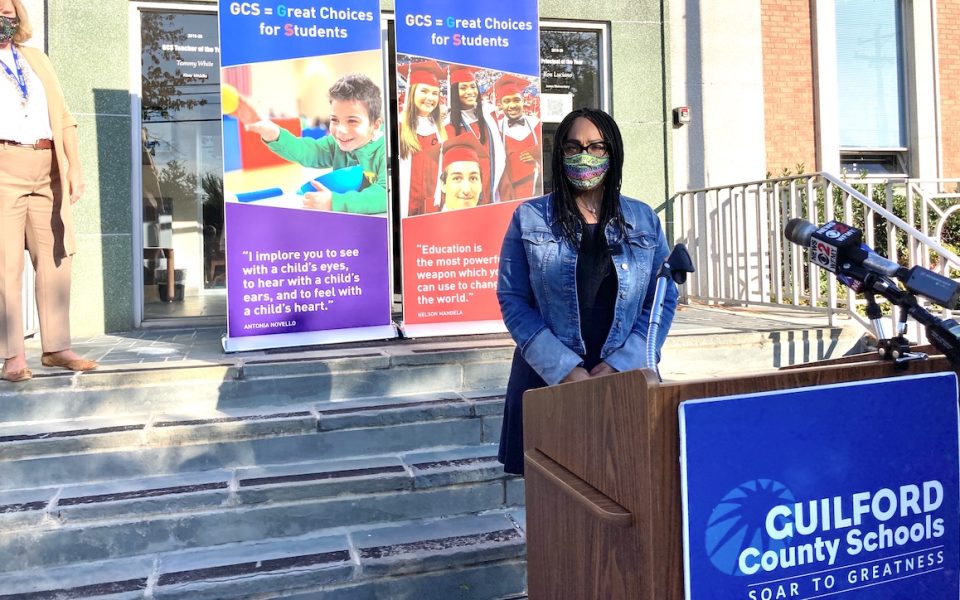Featured photo: Superintendent Sharon Contreras speaks during a press conference on Oct. 19 (photo by Sayaka Matsuoka)
Guilford County Schools Superintendent Sharon Contreras announced on Monday that most pre-K through second grade students will not be returning to in-person learning on Oct. 20 as had been originally planned.
Contreras, who spoke at a press conference on Monday afternoon, said that county health metrics, including risk of transmission, are too high to allow students to return to in-person learning. She added that the school board and school staff will meet on Friday, Oct. 23 to discuss whether students will be able to return on Monday, Oct. 26.
“We understand that this is frustrating for parents, students and staff,” Contreras said at the press conference. “We rely on public health partners and when public health says community spread has reached the highest category of transmission without signs of improvement, as educators we are going to listen.”
According to Dr. Iulia Vann, the director of the Guilford County Health Department, the number of cases per 100,000 persons as well as the number of new cases per 100,000 persons within the last two weeks in the county have signaled higher levels of community spread. The county’s daily COVID-19 positivity rates and hospitalization rates are also worsening. As of Monday, there were 10,304 confirmed cases of COVID-19 in Guilford county.
Parents who were hoping to send their kids back to school tomorrow have the option to enroll their children in the virtual academies, a separate school where kids can learn virtually, or opt for remote learning at their children’s assigned schools. At this point, Contreras said that 64 of the 69 elementary schools will be able to offer remote learning for students. Five schools — Shadybrook, Gillespie, Southern, Madison and Vandalia elementary schools — did not have enough students express interest in remote learning to have that as an option, according to Contreras. Three out of the five schools — Gillespie, Madison and Vandalia — are majority minority schools. The other two are schools with a very small student population.
“We had to have enough for a full classroom,” Contreras said. “We don’t have additional dollars to add any teachers…. It wouldn’t work if only nine students said they wanted to participate; they would have to attend the virtual school.”
Parent and community organizer Adrienne Spinner said that she’s frustrated at the school board and the superintendent’s miscommunication in the past several weeks. Spinner said she was initially told that her daughter’s school would not have remote learning as an option.
“We never have gotten a complete answer from Guilford county schools administration whether my daughter’s school was going to be in the boat of no remote or not,” Spinner said.
Spinner’s daughter has been doing remote learning like most children since August but Spinner enrolled her daughter in virtual academies for this semester because she was unsure if they would have the option to continue remote. Spinner also has another child in pre-K who is currently being homeschooled.
She said she doesn’t blame school administrators, who she believes get changing information on a daily basis.
“If you’re expecting school administrators to communicate to parents, they have to give them clear info,” she said. “Guilford County leadership is not being clear.”
She also said that she believes that a more coherent, clear plan could have come to fruition if school officials had spent more time listening to teachers and parents.
“If more consideration had been given to a complete voluntary re-entry since the beginning, then they could develop a process to reach vulnerable students without forcing this on everyone,” she said.
County officials have repeatedly pointed to a widening achievement gap for students who don’t return to in-person learning, and the fact that teaching kids at home is a privilege only afforded to families whose parents can stay at home with their kids. However, Spinner also noted that a disproportionate amount of kids who are contracting COVID-19 are Black and Brown and they are also being affected more severely.
“For these so-called vulnerable students, you’re forced to go back in the building,” she said.
According to CDC data from August, of 576 hospitalized children across the country, almost half were Latinx and 30 percent were Black. CDC studies also found that Latinx children were hospitalized with COVID-19 were eight times more likely than white children to require intensive care and Black children were five times more likely.
Spinner said that degrading school facilities with outdated HVAC systems, leaking roofs and mold are also concerning when thinking about sending kids back amidst a pandemic.
“If our county commissioners fully funded budget requests instead of spitting on public education for the past decade, we might not be arguing over whether to send students into buildings that are falling apart,” Spinner said. “We might have stood a chance at having some resources to make re-entry possible.”
In May, Guilford county commissioners voted to put forth a $300 million bond on the Nov. 3 ballot as opposed to a $1.6 billion bond requested by the school board. Voters can vote on whether to pass the $300 million bond, which would be used to fix old buildings and build new school facilities, this election cycle.
For now, Spinner said she’s waiting to hear whether her daughter will be attending the virtual academy or she’ll be able to continue remote learning through her school.
“We need to do better by [our teachers] and our students,” Spinner said. “Guilford county schools can do a lot better, and I hope they will stop passing the buck and do it.”
All third through fifth grade students are still scheduled to return to in-person learning on Nov. 4 or 5. Middle school kids are slated to return on Nov. 12. High school students would return on Jan. 20.
For more information on school reopening, visit gcsnc.com/Domain/18867.
Join the First Amendment Society, a membership that goes directly to funding TCB‘s newsroom.
We believe that reporting can save the world.
The TCB First Amendment Society recognizes the vital role of a free, unfettered press with a bundling of local experiences designed to build community, and unique engagements with our newsroom that will help you understand, and shape, local journalism’s critical role in uplifting the people in our cities.
All revenue goes directly into the newsroom as reporters’ salaries and freelance commissions.


Leave a Reply